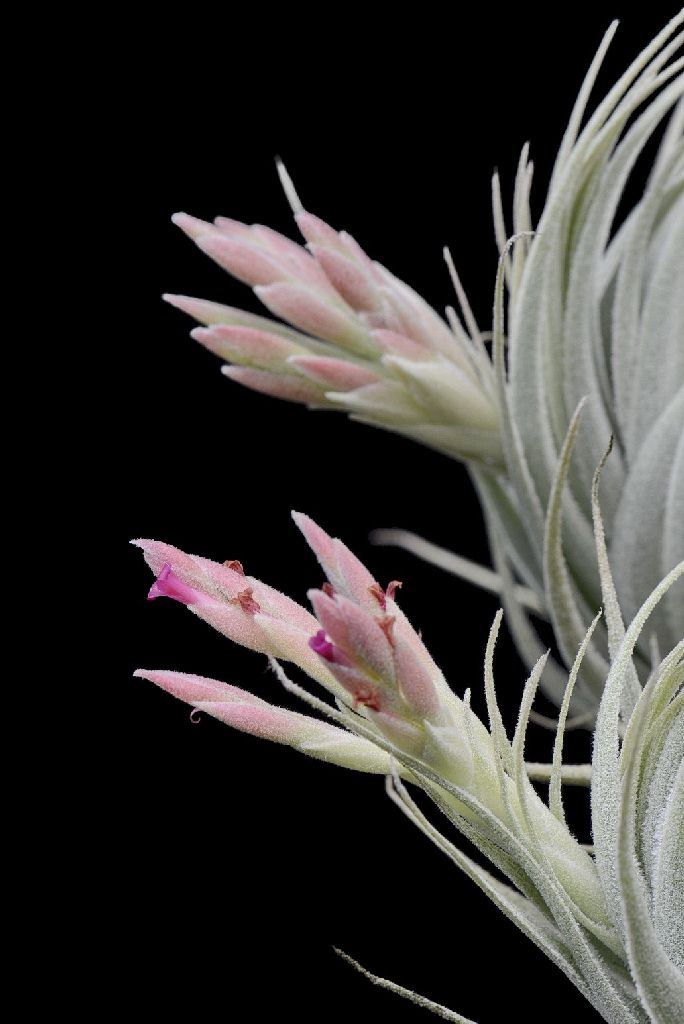
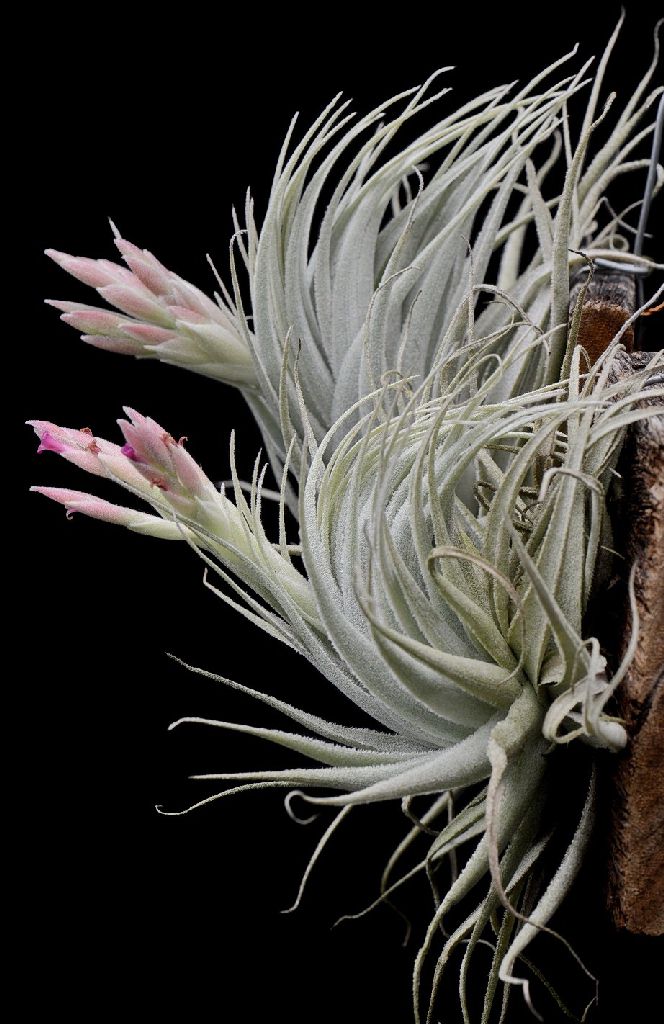
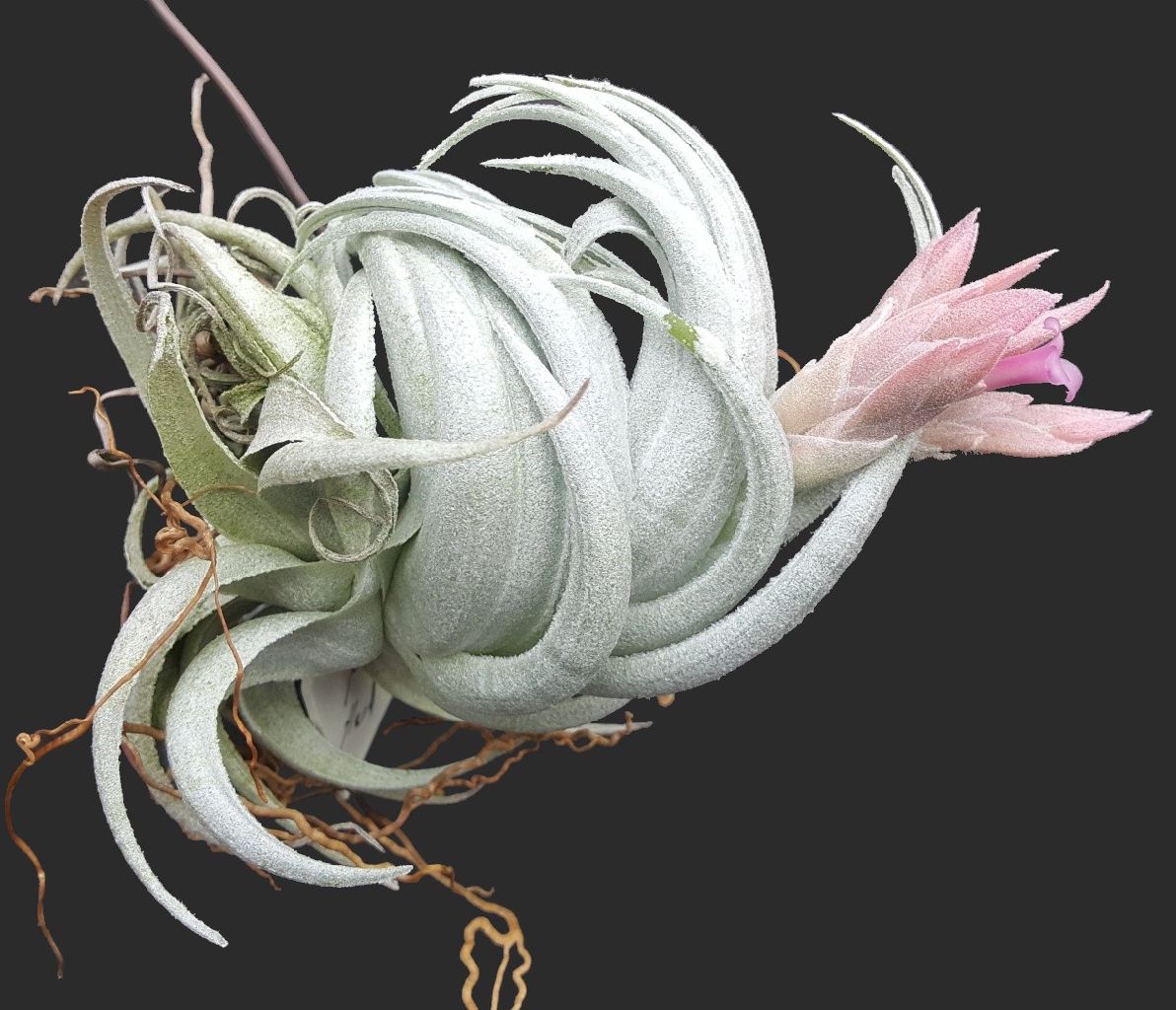
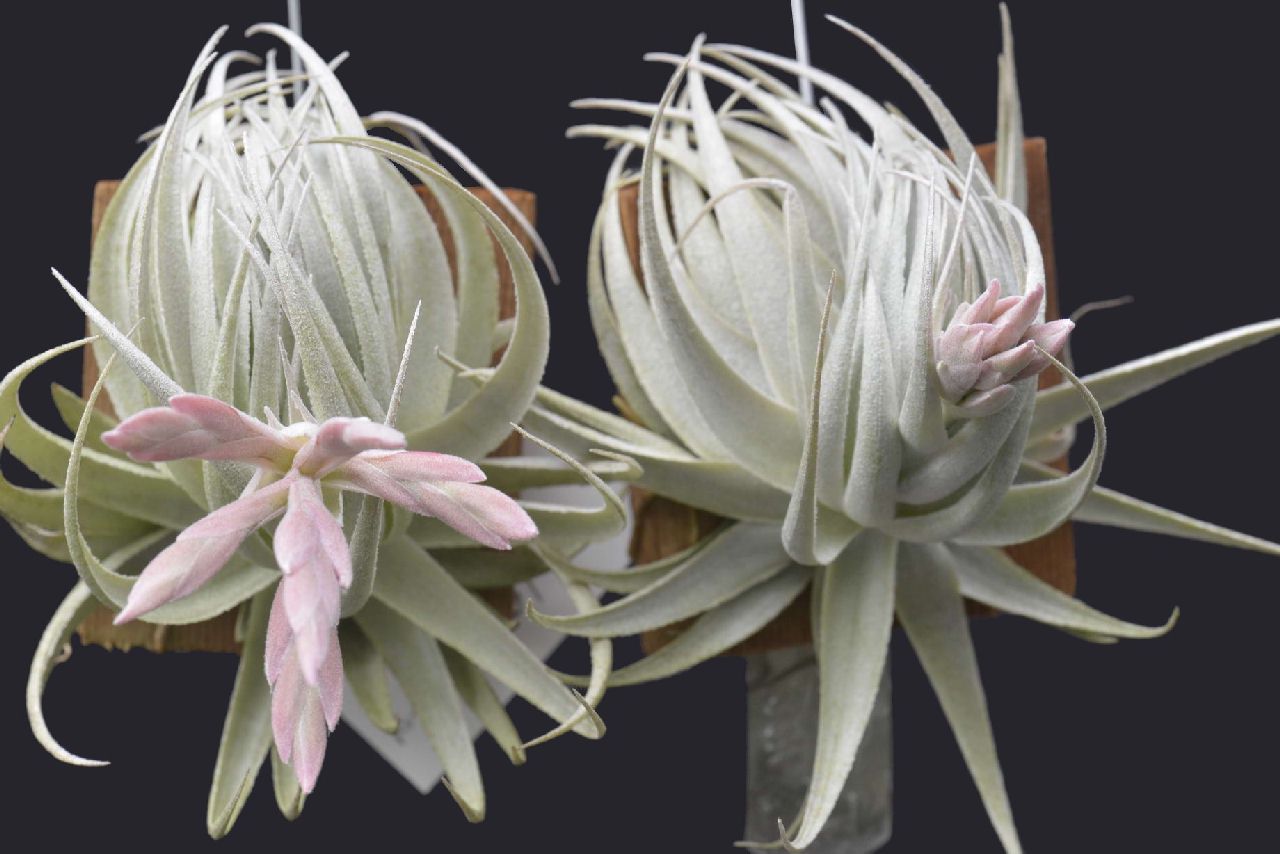
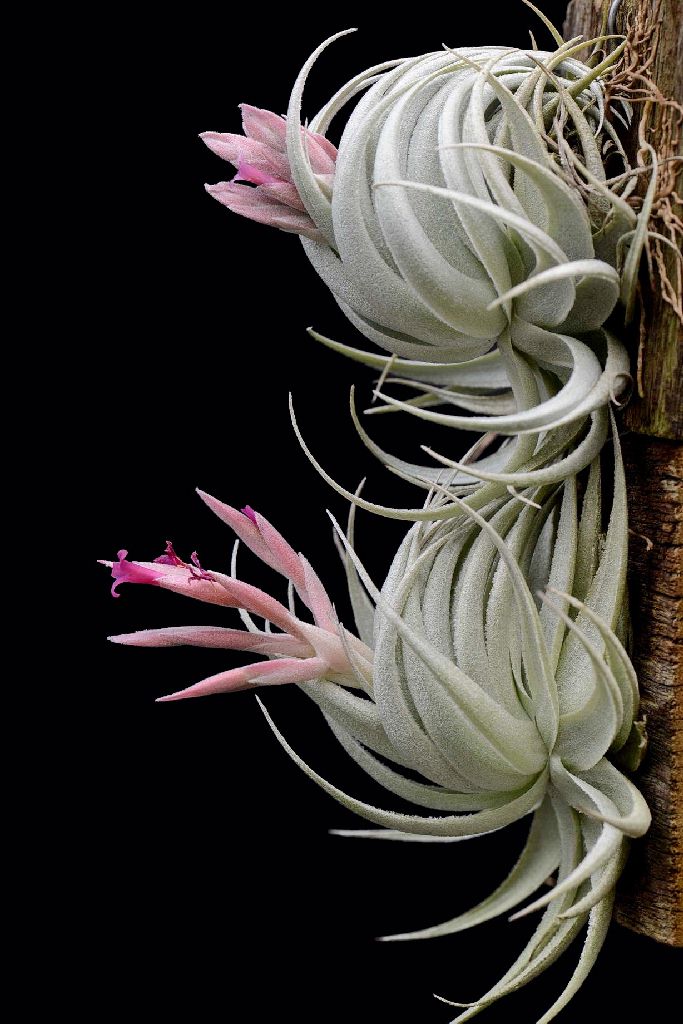
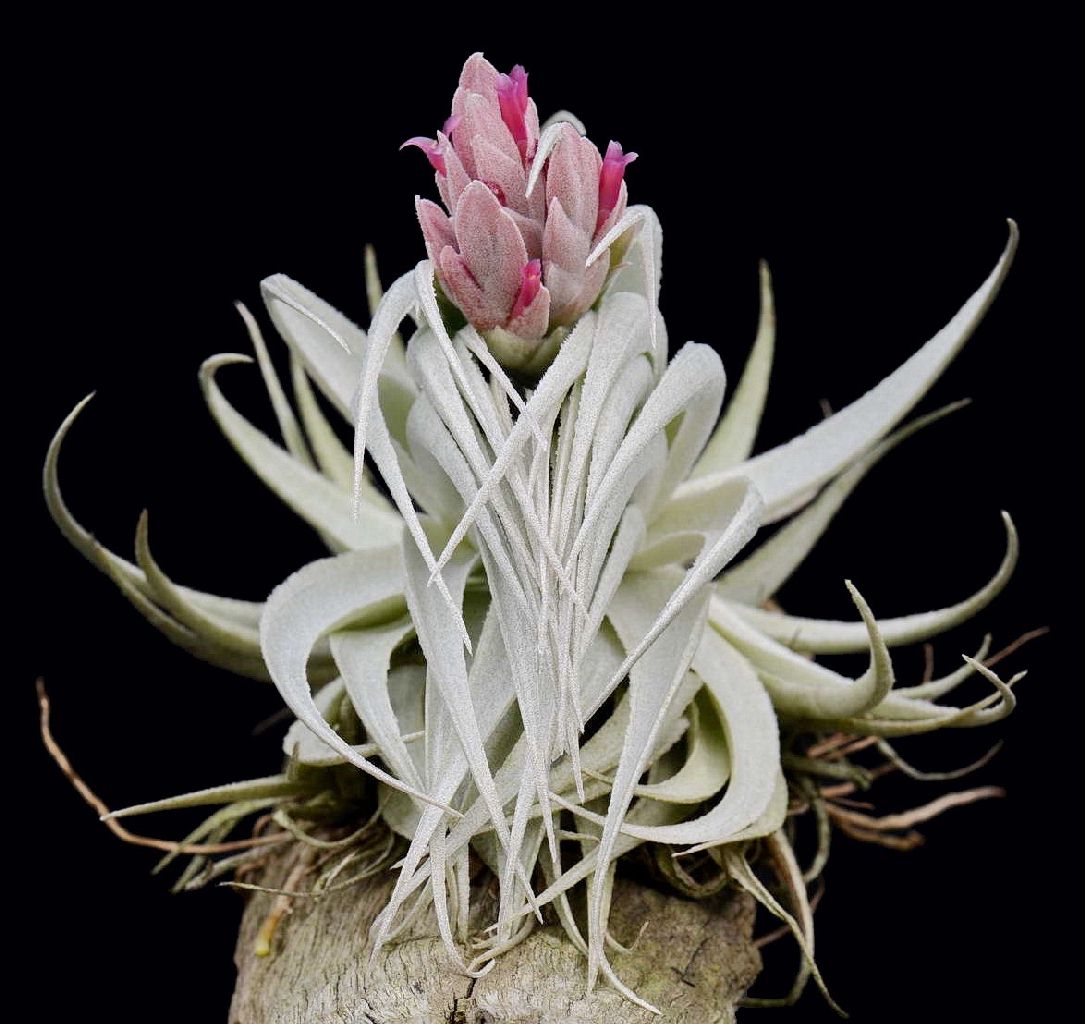
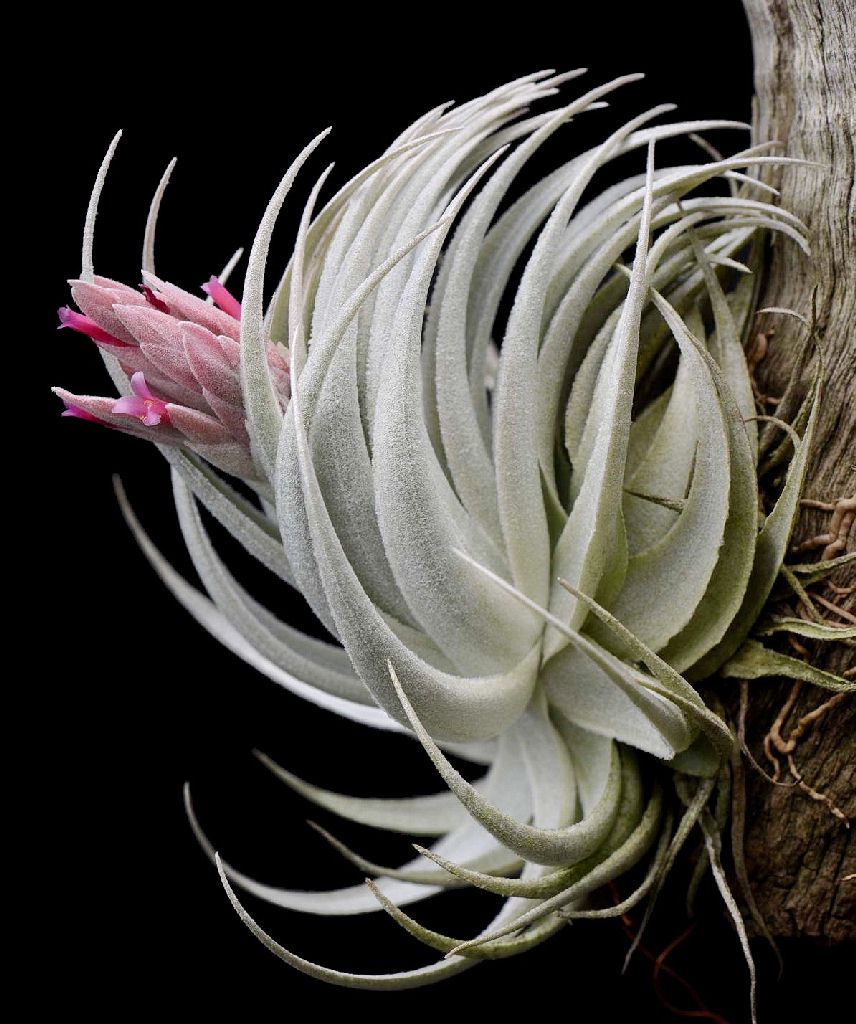
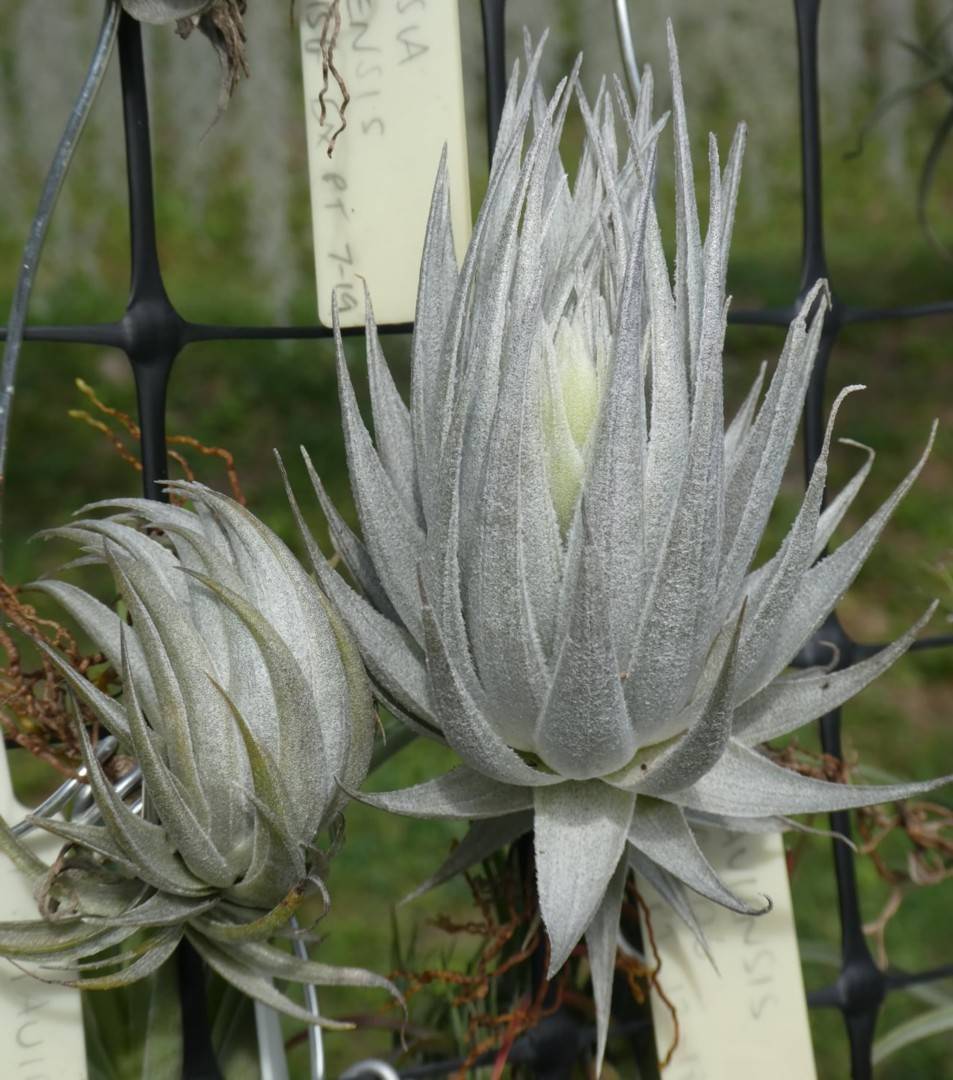
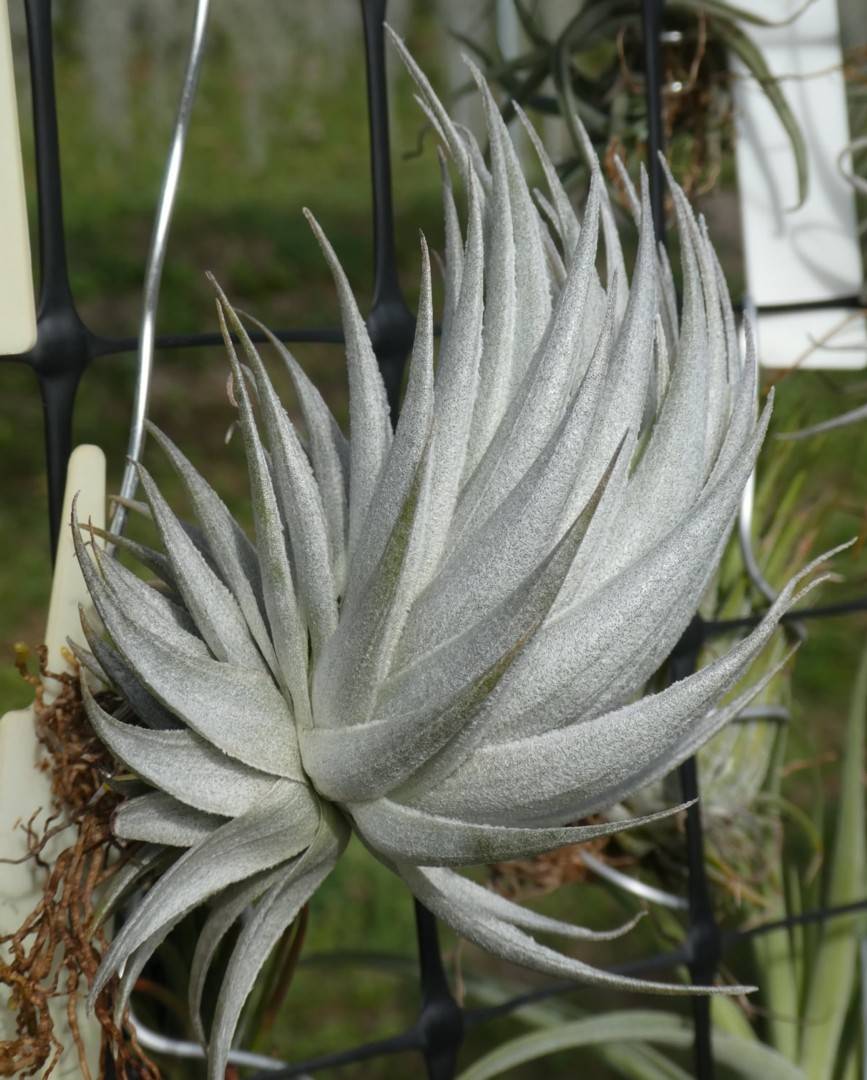
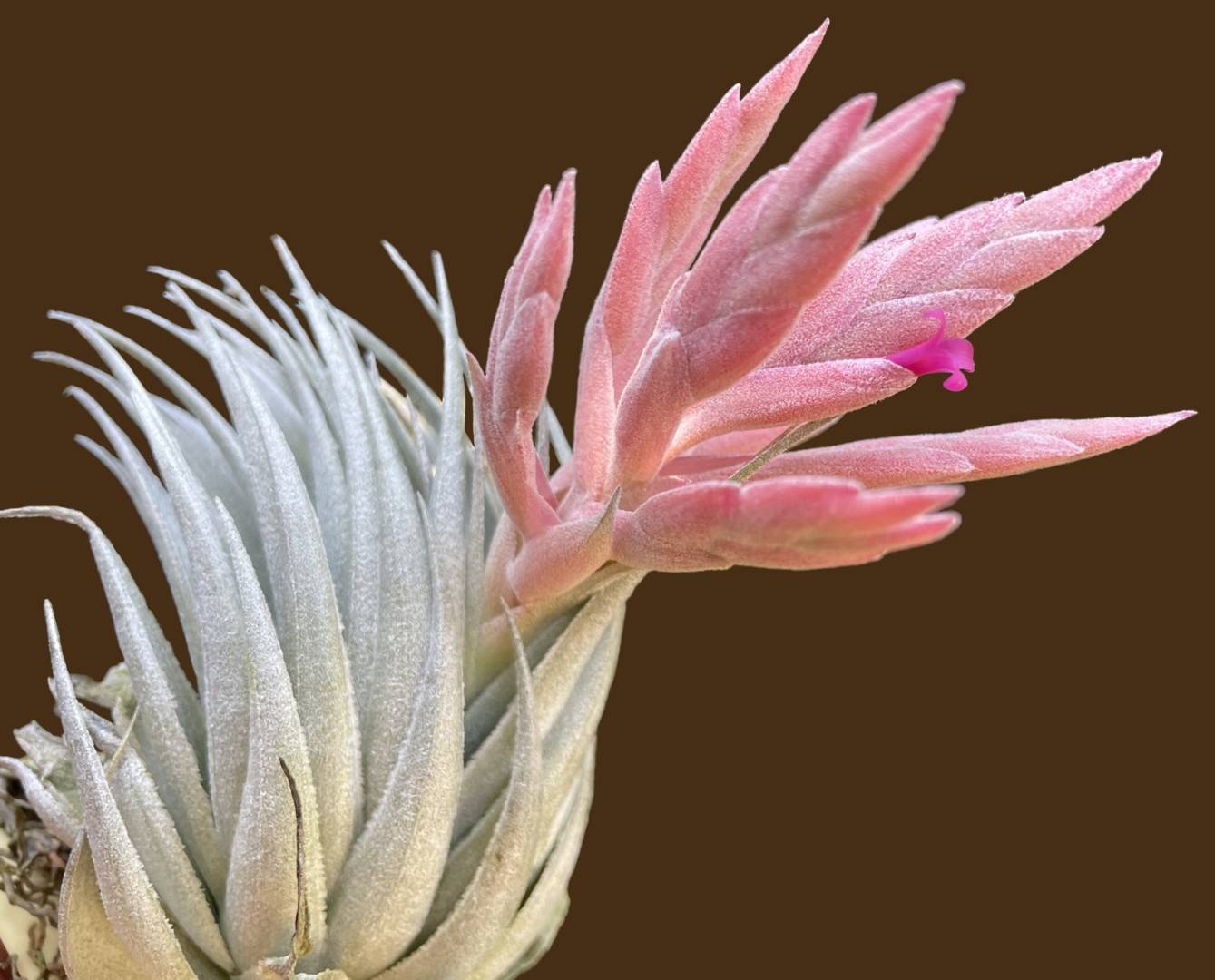
Plant growing on rocks, a stemless rosette, up to 12 cm high.
Leaves densely erect, up to 10 cm long, forming an erect, secund, stemless rosette of many leaves (up to 50), the inner leaves of the rosette densely claw-like bent, erect, the outer ones bending back, very stiff, somewhat succulent, both sides very densely appressed scaled, the scales overlapping each other, the edges bent and with coarse, asymmetrical scales.
Sheaths 8-11 mm wide at the base, indistinct, gradually merging into the blades.
Blades bent, triangular acuminate, only about as long as the sheaths.
Inflorescence never exceeding the leaves but shortly protruding from the side of the rosette.
Peduncle almost lacking, only 5-30 mm long and entirely hidden in the rosette, erect, at the base covered with a few peduncle bracts, narrow erectly appressed to the stem, 3 mm wide, up to 4 cm long, long acuminate, the upper ones broader and shorter, similar to the primary bracts.
Fertile part of the inflorescence laxly branched, 3-4 cm long, 3 cm in diameter, capitate, el1iptic, composed of 4-8 densely arranged, erect spikes, the slim axis of the inflorescence not visible at the time of anthesis.
Primary bracts much shorter than the spikes, 12-16 mm long, 10 mm wide at the base, oval, only shortly tipped, densely fine lepidote.
Spikes 2.0-3.5 cm long, 7-9 mm wide, narrowly lanceolate, flatpedicel flat, 5-10 mm long, 4 mm wide,
flowers 3-6 per spike, distichous, laxly arranged, at base and apex 1-2 flowerless floral bracts on the stem and at the top, the axis not visible at anthesis,
Floral bracts 14-16 (20) mm long, about as long as the sepals or exceeding these by about 1 mm, 5-8 mm wide, oval, acuminate, keeled, thin membranous, pink, abaxial side densely covered with tiny scales, adaxial side glabrous and somewhat nerved,
Flowers sessile, up to 20 mm long,
Sepals 13-15 mm long, 3.5 mm wide, lanceolate, acuminate, thin membranous, glabrous, pink, the lower part green, the adaxial pair keeled and 2-3 mm connate,
Petals 21-25 mm long, 3.5 mm wide, tongue-shaped, dark pink, the lower third white, the rounded tips clearly recurved.
Stamens enclosed in the flower.
Filaments 15 mm long, 1 mm wide, ribbon-like, thinner towards the top, the upper third folded many times,
anthers 3 mm long, 0.5 mm wide, joined at the base,
yellow style 8 mm long, thin, white.
Similar species :
Tillandsia piauiensis shares the most characteristics with T. gardneri var rupicola E. Pereira. Dr. Till drew our attention to the fact that Elton Leme's field research showed that T. gardneri is found predominantly in offshore areas whereas T. chapeuensis Rauh colonises regions far from the shore in north-eastern Brazil. He recommended us to examine the relationship to the latter as well and so we worked out differential diagnoses for both species.
Tillandsia piauiensis differs from T. gardneri var. rupicola (syn. T. gardneri var. cabofrioensis Weber & Ehlers) in the following characteristics:
Plant stemless, not long-stemmed, forming a compact, closed rosette with more densely overlapping leaves. Leaves narrower, the bases of the sheaths only up to 11 mm instead of up to 20 mm wide, harder and a little more succulent, with very densely appressed scales instead of protruding scales, brilliantly whitish grey, not satiny whitish grey. Peduncle completely hidden in the rosette, very short to almost lacking, inflorescence never exceeding the leaves but protruding at the side of the rosette. Primary bracts shorter, spikes much narrower, only 7-9 mm instead of 14 mm wide, with longer stem and flowerless floral bracts, the floral bracts wider and petals longer.
Tillandsia piauiensis differs from T. chapeuensis in the following characteristics :
Compactly closed rosette with stiff, harder and more succulent, claw-like bent leaves, leaves shorter and narrower at the base, blades much shorter with very densely appressed scales instead of dense protruding scales, brilliantly whitish grey, not satiny whitish grey, a much shorter peduncle with only a few short and short tipped peduncle bracts and a capitate inflorescence composed of densely arranged erect, shorter and narrower, not digitate spreading spikes.
The significant differing characteristics are summarized in the table, adding Tillandsia gardneri var. gardneri for comparison.
NOTES
In 1987, this plant was exported by Mr. E. Pfister from Brazil and was sold at orchid shows as well as by FEMO, a (former) large German Tillandsia wholesaler. I bought some plants from them. Like many other Bromeliad lovers, I was fascinated by this beautiful, white, claw-shaped Tillandsia, which was a piece of jewellery even without a flower. In April 1988 one of these flowered in my collection. The inflorescence was very similar to Tillandsia gardneri, but composed of more densely arranged spikes and an almost completely missing peduncle.
In 1993, another plant came into flower.
In 1988, I met Mr. Pfister and interviewed him about this plant. He told me that it was found in the borderland between Pernambuco and Piaui in northeastern Brazil and that it was growing on rocks. On a map he showed me the area of provenance without telling me the exact locality. His only hint was: when you drive on the main road from Recife to Piaui, the grey claw plant grows near the border of Pernambuco. I asked him to collect this plant once more and to tell me the exact locality because I intended to publish this beautiful Tillandsia as a new species. He made the most solemn promises to do so, but unfortunately, he never kept his promise. Whenever I met him in the following years, he always told me that he had not yet visited that area again. When I asked for the exact locality again, he finally confessed that he had not collected the plants himself but got them collected by locals who gave the plants to him.
In 1997, Reinhold Thieken and Harro Heidt tried to find the plant in the border region between Pernambuco and Piaui. For days, they wandered through the area, but to no avail. They could not find this beautiful small Tillandsia.
In my booklet "The Red-Flowered Tillandsias from Brazil" (Ehlers 1996), this plant is portrayed on page nineteen. Although it was clear to me that we were not dealing with
a Tillandsia gardneri, l did not publish this species because, whenever possible, I only publish species that I've seen myself in habitat or know the exact collection locality.
Recently, Jan Claus (2010) referred to this plant in his article 'Alles Tillandsia gardneri?" and reports that the short, hard and compact secund rosettes vary considerably from the many forms of T. gardneri with their spreading rosettes of soft, thin, partially bent back leaves. We discussed this plant for ages on the telephone and have finally decided to work on it. He sent me a fresh inflorescence and took exact measurements of the plants in his collection. After examination of all the details we decided to publish this plant as a new species.
At first, we wanted to name it Tillandsia pernambucensis, but Dr. Walter Till called our attention to the fact that this name had already been used by E. Pereira: T. pernambucensis E. Pereira is now treated as a synonym of T. tenuifolia var. tenuifolia L. We were very glad to avoid such a mistake thanks to his help and decided to name the plant T. piauiensis, because the habitat is located in the border region of the State of Piaui.
History and remarks
In my article about Tillandsia gardneri (Claus 2010) I wrote about the different forms of T. gardneri and asked the experts amongst us to work on this complex. As a result, Renate Ehlers, who had worked on that complex for many years, asked me for the differences from my point of view and requested a list of these differences. I didn't have to be asked twice and immediately took my slide gauge and started to take a measurement of all my "forms" of T. gardneri (and I have got many of them). The dimensions were taken from several plants that could be regarded as a group in order to get average data. I sent my results to Renate. After examination of my measurements, her interest was awaked again and she asked me to send a sample of my plants in order to check the correctness of my statements. Although I do not like to cut parts from my plants I sent her inflorescences and leaves of my different plants, that she compared with her own material collected over the years.
After evaluation of our data, we asked ourselves if there were enough deviating characteristics to describe the "claw-form of the Tillandsia gardneri" as a new species or at least as a subspecies. We discussed the matter over a long time and even considered possible variation in dimension caused by cultivation conditions. Descriptions of new species should generally be based on as many fresh wild collected plants as possible and not from cultivated plants that might have changed their form. The fact that we both got our "claw-form of the Tillandsia gardneri" as relatively fresh collected plants and we did not notice any changes of their form through decades of cultivation, made us decide to deviate from this optimum.
As to my question, how a correct plant description should be done, I have, to this day, no really satisfying answer. It always seems to be a matter of discretion! On this occasion, I would like to remind you of Tillandsia carminea W.Till, that only differs from T. stricta by its secund leaves and its elongated stem. If the status of this species is not at all called into question, I consider it to be justified to publish T. piauiensis as a new species, because this plant differs in many more characteristics.
Jan Claus
Birkenweg 3, D-14621 Schonwalde-Glien